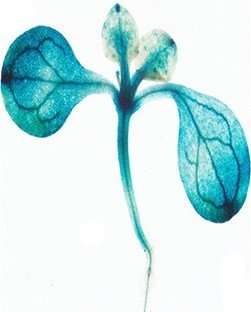The expression pattern of CTL1 gene reporters in Arabidopsis seedling. Credit: Sheng Luan
A protein that transports the simple chemical choline plays a major role in vesicle trafficking, ion homeostasis, and growth and development in plants, according to two new studies publishing 28 December in the open-access journal PLOS Biology, by Dai-Yin Chao of the Shanghai Institutes for Biological Sciences, China, and Sheng Luan of the University of California, Berkeley, and co-workers.
The protein, called choline transporter-like 1 (CTL1), had been previously identified as essential for formation of sieve plates, cell wall perforations that regulate passage of materials in plant phloem. But the mechanism of its function, and whether it played other roles in plants, was unknown. Chao and colleagues found CTL1 while screening for genes that control ion homeostasis in the model plant, Arabidopsis thaliana. They found that loss of CTL1 in the root led to ion disturbances in leaves, and deformations in plasmodesmata, a type of intercellular channel, in the root. CTL1 mutation also altered the distribution of ion transporters, which, combined with previous work localizing CTL1 to the trans-Golgi network, led the authors to investigate whether CTL1 played a direct role in vesicle trafficking. Sure enough, they showed that loss of CTL1 disrupted localization of multiple proteins, including an auxin transporter - auxin is the main growth hormone in plants.
Luan and colleagues began by mapping the distribution of CTL1 in Arabidopsis, and found that it was ubiquitous but was highest where auxin was highest: in the growing tips, in the vascular tissue, and in the "apical hook" that seedlings lead with as they push up through the soil. Intracellularly, they too found that CTL1 localized to the trans-Golgi network, and appeared to control trafficking to and from the plasma membrane; the authors observed that without CTL1, auxin transporters were misdirected, and the plant displayed the classic signs of auxin loss, including lack of cell elongation.
Chao also showed that excess choline inhibited endocytosis, mimicking the effects of CTL1 loss and suggesting that a critical CTL1 function is to sequester choline into endosomes. They suggest that keeping choline levels low outside endosomes promotes the activity of an enzyme, phospholipase D, that cleaves multiple lipids and, in so doing, has a direct effect on vesicle lipid composition and thus destination. In this model, loss of CTL1 raises choline, which inhibits the enzyme, altering vesicle lipids, and ultimately misdirecting the vesicles, which would account for the multiple effects of CTL1 mutation, including ion imbalances, plasmodesmata defects, and auxin mislocalization.
CTL1 is also found in animal cells, Chao noted, and thus the study concluded that "characterizing CTL1 as a new regulator of protein sorting may enable researchers to understand not only ion homeostasis in plants but vesicle trafficking in general."
More information: (C): Gao Y-Q, Chen J-G, Chen Z-R, An D, Lv Q-Y, Han M-L, et al. (2017) A new vesicle trafficking regulator CTL1 plays a crucial role in ion homeostasis. PLoS Biol 15(12): e2002978. doi.org/10.1371/journal.pbio.2002978
(L): Wang Y, Yang L, Tang Y, Tang R, Jing Y, Zhang C, et al. (2017) Arabidopsis CTL1 regulates secretory trafficking of auxin transporters to control seedling growth. PLoS Biol 15(12): e2004310. doi.org/10.1371/journal.pbio.2004310
Journal information: PLoS Biology
Provided by Public Library of Science























